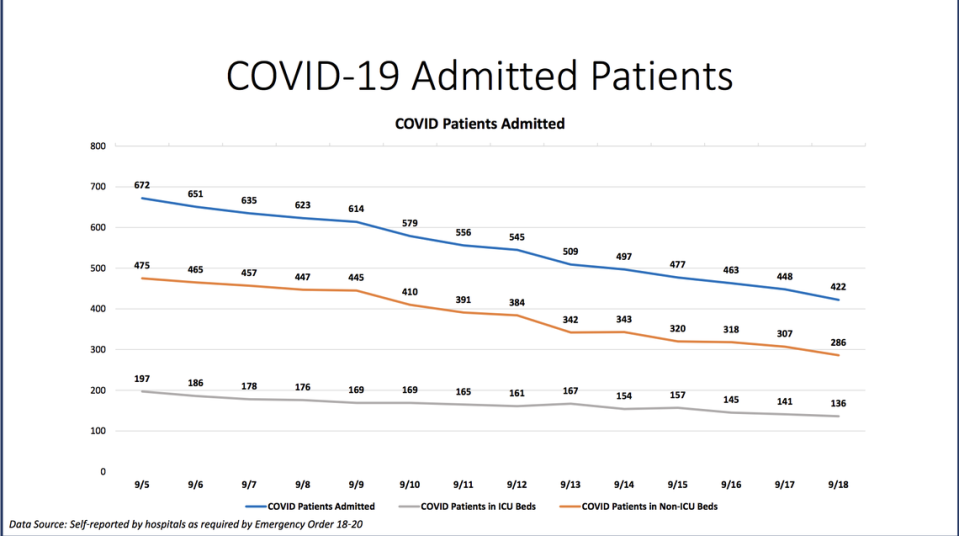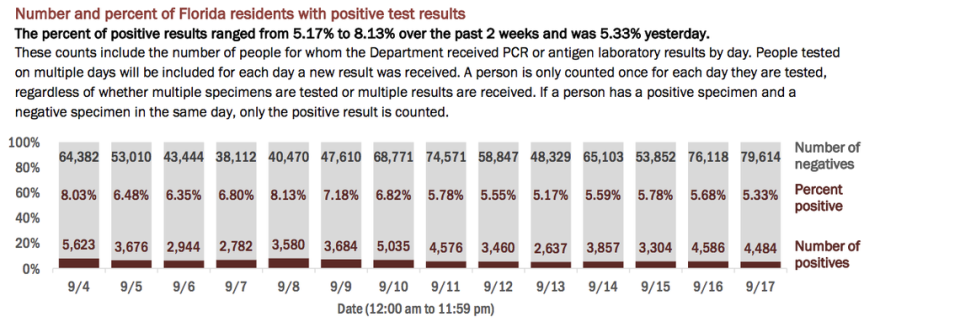Miami-Dade coronavirus death toll hits 3,000 as Florida adds 3,204 new cases
Florida’s Department of Health on Friday confirmed 3,204 additional cases of COVID-19, bringing the state’s known total to 677,660. There were also 139 Florida resident deaths announced, bringing the resident death toll to 13,225.
One new non-resident death was also announced, bringing the non-resident toll to 162.
Confirmed COVID-19 cases in South Florida
▪ Miami-Dade County reported 385 additional confirmed cases of COVID-19 and 50 new deaths, according to Florida’s Department of Health. The county now has 165,980 confirmed cases and 3,027 deaths. Percent positivity for new cases: 3.63%. The 14-day positivity average is 4.93%, according to Miami-Dade County’s “New Normal” Dashboard.
▪ Broward County reported 218 additional confirmed cases of the disease and six new deaths. The county has a known total of 75,266 cases and 1,317 deaths. Percent positivity for new cases: 3.36%.
▪ Palm Beach County saw 223 additional confirmed cases and 18 new deaths. The county now has 44,906 confirmed cases and 1,272 deaths. Percent positivity for new cases: 3.77%.
▪ Monroe County confirmed two additional cases and no new deaths. The county’s known total is at 1,801 cases and 22 deaths. Percent positivity for new cases: 0.93%.
COVID-19 could be the leading cause of death in Miami-Dade County by the year’s end
COVID-19 hospitalizations in Florida
One of the tools that officials rely on to determine whether the coronavirus situation is improving in the state is hospitalization data. Unlike testing, which might be limited or take days to report results, hospitalizations can help give officials a real-time snapshot of how many people are severely ill with COVID-19.
The Florida Agency for Health Care Administration reports the number of patients hospitalized statewide with a “primary diagnosis of COVID.” The data, which is updated at least every hour, does not distinguish between the number of COVID-19 patients in hospital intensive care units and those in acute-care beds, which require less attention from nurses.
Previously, the state was providing only the total number of hospitalizations in its statewide and county-level data. Miami-Dade was an exception, with hospitals self-reporting a number of key metrics, including hospitalizations, to the county, which has made this data public for several months.
As of 2:35 p.m. Friday, there were 2,382 COVID-19 patients admitted into hospitals throughout the state, according to the Florida Agency for Health Care Administration dashboard. This is a significant decrease from early August, when more than 5,000 COVID-19 patients were admitted into hospitals throughout the state.
Of Friday’s hospitalizations, 348 were in Miami-Dade, 245 in Broward, 157 in Palm Beach and two in Monroe counties, according to the agency.
Florida’s current hospitalization data does not always match the hospitalization data reported in Miami-Dade’s “New Normal” dashboard. Officials say this could be for a number of reasons, including the frequency of daily updates.
On Friday, Miami-Dade hospitalizations for COVID-19 complications decreased from 448 to 442, according to Miami-Dade County’s “New Normal” dashboard. According to Thursday’s data, 78 people were discharged and 49 people were admitted.

The state has had a total of 42,234 Florida residents hospitalized for COVID-19-related complications, according to Florida’s COVID-19 Data and Surveillance Dashboard.
COVID-19 Testing in Florida
Testing in Florida has seen steady growth since the COVID-19 crisis began.
Testing, like hospitalizations, helps officials determine the virus’ progress and plays a role in deciding whether it is safe to lift stay-at-home orders and loosen restrictions.
Epidemiologists then use the testing data to create a positivity rate. The rate helps them determine if a rise in cases is because of an increase in testing or if it means there’s increased transmission of the virus in the community.
On Friday, Florida’s Department of Health reported the results of 84,098 people tested on Thursday. The positivity rate of new cases (people who tested positive for the first time) was 4.18%.

If retests are included — people who have tested positive once and are being tested for a second time — the positivity rate was 5.33% of the total, the report said.
How hard will COVID-19 hit Miami-Dade this fall? We explored the potential scenarios

